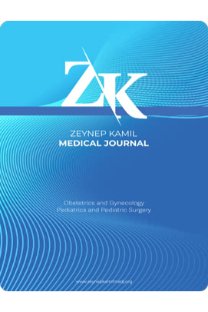NEKROTİK TORSİYONE PARATUBAL KİST İLE BERABER INTAKT FALLOP TÜP TORSİYONU: OLGU SUNUMU
Akut Karın, Laparatomi
INTACT FALLOPIAN TUBE TORSION ACCOMPANYING NECROTIC PARATUBAL CYST TORSION: CASE REPORT
Acute abdomen, Laparotomy,
___
- 1) Houry D, Abbott JT. Ovarian torsion: a fifteen-year review. Ann Emerg Med 2001; 38(2): 156-9.
- 2) Bland SJ. Remarks on salpingitis and some of its effects. Lancet 1890; 136:1146–8.
- 3) Hansen OH. Isolated torsion of the fallopian tube. Acta Obstet Gynecol Scand 1970; 49(1): 3–6.
- 4) Wong S-WA, Suen S-HS, Lao T, Chung K-HT. Isolated fallopian tube torsion: a series of six cases. Acta Obstet Gynecol Scand 2010;89(10):1354–6.
- 5) Kumari I, Kaur S, Mohan H, Huria A. Adnexal masses in pregnancy: a 5-year review. Aust N Z J Obstet Gynaecol 2006; 46(1): 52-4.
- 6) Comerci G, Colombo FM, Stefanetti M, Grazia G. Isolated fallopian tube torsion: a rare but important event for women of reproductive age. Fertil Steril 2008; 90(4): 1198.e23.
- 7) Harmon JC, Binkovitz LA, Binkovitz LE. Isolated fallopian tube torsion: sonographic and CT features. Pediatr Radiol 2008; 38(2):175-9.
- 8) Ghossain MA, Buy JN, Bazot M. CT in adnexal torsion with emphasis on tubal findings: correlation with US. J Comput Assist Tomogr 1994; 18(4): 619-25.
- 9) Huchon C, Fauconnier A. Adnexal torsion: a literature review. Eur J Obstet Gynecol Reprod Biol 2010; 150(1): 8-12.
- 10) Oelsner G, Shashar D. Adnexal torsion. Clin Obstet Gynecol 2006; 49(3): 459-463.
- ISSN: 1300-7971
- Yayın Aralığı: 4
- Başlangıç: 1969
- Yayıncı: Ali Cangül
GEBELİKTE OLAĞAN FİZİKSEL YAKINMALAR
Fatma Coşar Çetin, Nurdan Demirci, Kıymet Yeşilçiçek Çalık, Ayşe Çil Akıncı
NEKROTİK TORSİYONE PARATUBAL KİST İLE BERABER INTAKT FALLOP TÜP TORSİYONU: OLGU SUNUMU
MEHMET AKİF SARGIN, Murat YASSA, Mehmet TURUNÇ, Emrah ORHAN, Niyazi TUĞ
Çocukluk Çağı Tümörlerinin Akciğer Metastazlarına Cerrahi Yaklaşım
RAHŞAN ÖZCAN, Ayşe KARAGÖZ, Ebru GÖKDEMİR, PINAR KENDİGELEN, Tiraje CELKAN, İBRAHİM ADALETLİ, Osman F. ŞENYÜZ, Gonca T. TEKANT
Sezaryenlerde Plasentanın Myometrium ile İlişkisinin Değerlendirilmesi
Busra Demir CENDEK, Filiz Ayse AVSAR, Ozlem SARICI, Aylin Kılıç YAZGAN, Ali İPEK, EVRİM BOSTANCI ERGEN
Gebelıkte Olağan Fızıksel Yakınmalar
FATMA COŞAR ÇETİN, NURDAN DEMİRCİ, KIYMET YEŞİLÇİÇEK ÇALIK, AYŞE ÇİL AKINCI
Astım tedavisinde D vitamininin yeri
Mehmet Yaşar Özkars, Özlem Keskin, Ercan Kucukosmanoglu, Hasan Ulusal, Mustafa Örkmez
Plasenta perkretada çevresel rezeksiyon tekniği: bir fertilite koruyucu yaklaşım
MURAT EKİN, Cihan KAYA, Gülsen AKYILDIZ, LEVENT YAŞAR
Çocuklarda Postpnömonik Ampiyem: Retrospektif, Tek Merkez Çalışması
Feride MEHMETOĞLU, Emine KINACI, Mensur SÜER
Vulvada Paraüretral Ekstra Gastrointestinal Stromal Tümör: Olgu Sunumu
Mesut TEK, İdris AYDIN, Yasemin Yuyucu KARABULUT, Mürşide Çevikoğlu KILLI
SEZARYENLERDE PLASENTANIN MYOMETRİUM İLE İLİŞKİSİNİN DEĞERLENDİRİLMESİ
Busra Demir Cendek, Filiz Ayse Avsar, Ozlem Sarici, H. Levent Keskin, Aylin Kılıç yazgan, Ali İpek, Evrim Bostancı
